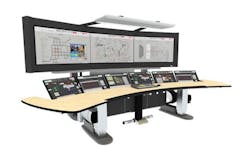The Case for More Colorful HMI Graphics
Though increasing numbers of industrial operators and engineers note a preference for high-performance HMIs, i.e., HMI screens that are primarily gray scale and use color only to highlight assets or operations requiring immediate attention, many industrial HMI users still prefer high-intensity HMI graphics. Often, their intention is to add a touch of realism to the piping and instrumentation diagrams (P&IDs) and other graphical representations in control rooms.
Such realism also allows machine builders to encode some help for operators inside the HMIs. As the cost of system memory continues to fall, more HMI manufacturers are exploiting the economics to offer features such as video clip storage and playback. “Machine builders are quick to pick up on this feature to embed things like operator instructions or machine fault diagnostic videos,” says Clark Kromenaker, product manager at Omron Automation.
A touch of realism on faceplates, for example, can also enhance the safety of interacting with a machine. “The operator can adjust the HMI-displayed template of an array of smart sensors, just as if he had the control cabinet door open and was making adjustments to the physical device itself,” Kromenaker explains. “So, such a faceplate enables a more realistic virtual involvement with parts of the machine without some of the hazards that might be present if the control cabinet door was actually opened.” Such faceplates also exist for recipes and alarms.
In contrast to some operators' preference for colorful HMI graphics, others point to studies that link inappropriate HMI design to operator error and low productivity. Investigative bodies such as the U.S. Chemical Safety and Hazard Investigation Board, have identified HMIs as causal factors in the Texaco Pembroke, Esso Longford and BP Texas City explosions. And a study commissioned by the U.S. Navy found that users of simple, abstract graphics outperformed users of video game-style graphics by 70%—despite an overwhelming preference among the users for the video game look.
Despite the proven success of high-performance HMIs, consumer applications of graphics technology will likely continue to lead industrial applications and be a testing ground for industry. HMI developers are already trying to build on the experience that people have with their tablets and smartphones at home. “Beyond generating a comfort level among users, this (advanced graphics use in HMIs) can go a long way toward perfecting the user experience and shortening the learning curve for machine operators,” observes Eric Reiner, industrial PC market specialist at Beckhoff Automation.


